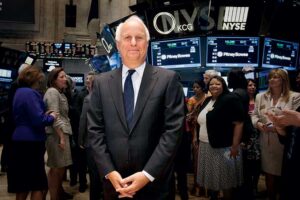- Big Decision
- Client Stories
- Executive Profiles
- IQ Insigniam Quarterly® Magazine
- Transformational Leadership
The Evolution of Pitney Bowes
Pitney Bowes could have easily been wiped out by the digital revolution. But when Marc Lautenbach was brought on board as president and CEO, he made a commitment to accelerate the transformation of the multibillion-dollar organization into what is now billed as a “global technology company.” It is the stuff of leadership legend, and yet Mr. Lautenbach says the true test of his—and any executive’s—big decision comes in the follow-through.
“Many large organizations tend to employ the same strategies when they pursue change or have change thrust on them by market forces,” he says. “Success is not so much a question of decisions on strategic choice as it is a question of your capability and fortitude to stay on the new course you’ve chosen.”
For more than 90 years, Pitney Bowes has been synonymous with postage meters, supplying its more than 1 million customers (including 90 percent of global Fortune 500 companies) with mailing services. But as customers transitioned many of their communications efforts from paper to online, the company needed to make its own transition. That evolution began in full force shortly after Mr. Lautenbach arrived at the company’s headquarters in Stamford, Connecticut, in December 2012.
The transformation process can be challenging, however, with revenues falling in four of the last five years. Even as net income spiked from $143 million in 2013 to $408 million in 2015, revenues fell from $3.9 billion to $3.6 billion during the same period.
Many executives might start doubting their decisions. But Mr. Lautenbach remains steadfast in his mission to make Pitney Bowes a major player in e-commerce.
“We have continually decided to choose the alternative that creates the most long-term value, even if it creates short-term disruptions,” he says. “And in today’s world of the equity markets, that’s something that’s challenging. I think most companies bow to that pressure, and that’s why most companies don’t end up transforming themselves. They make decisions thinking something is the right long-term bet and then, when things start going the wrong way, they don’t have the fortitude to stick with it.”
New Directions
Transformation does not always require wholesale reinvention. As he looked to make Pitney Bowes a relevant digital player, Mr. Lautenbach aimed to build on its core strengths and identity, redefining it for a new context.
The process began by examining the company’s true north—the vision, values and services that define the organization and make it tick. The decisions Mr. Lautenbach made from then on built upon that foundation.
“As you’re thinking about transforming a company, or at least as I thought about transforming Pitney Bowes, you try to realize those cores, those gems that you have that you can pivot off of to create that next chapter,” he told Fortune. “We have been and continue to be a mail company, but there’s other germs of that business that we can begin to create our new future.”
Under Mr. Lautenbach, for example, Pitney Bowes added an entirely new but related business unit focused on digital tools and services, including mobile apps, that now delivers more than $1 billion of annual e-commerce business. Online marketplace eBay, for one, uses Pitney Bowes software to automatically determine where any given package can be shipped internationally and how much the duty on that item will cost. Another piece of Pitney Bowes software pinpoints the locations of 1.2 billion users of social media for the likes of Twitter, Zillow and other social platforms.
“To a degree, decision-making and strategies are the easiest part of the process. How you communicate the decisions, how you manage the change, how you drive those decisions, is the difficult part.”
Such high-profile customers have helped bring digital services up to 10 percent of overall revenue at Pitney Bowes, with digital sales jumping 29 percent in 2015. As Mr. Lautenbach told The Wall Street Journal in 2016: “Very few things are quite as profitable as a mail meter. But software is one of those businesses that actually has very attractive margins, and it makes this equation a lot easier to close.”
To create a new future for a company, however, leaders cannot simply consider what it could be—they must also know what it will never be. Mr. Lautenbach, for example, is quick to point out that Pitney Bowes is not a logistics company. He does not see Pitney Bowes as a competitor to the likes of UPS or FedEx. Instead he sees them as partners, with Pitney Bowes enabling their efforts.
“We solve a problem that starts with the cart and the cart management and consumers buying online, all the way through the shipping,” he told Fortune. “So, there’s a bunch of complicated stuff in the middle of those transactions—customs, duties, who the right shipper is—and Pitney Bowes solves all that. If you think about the core of that solution, where we started, it was online postage. We’ve just moved left and right. And that to us is the recipe for how you transform a company. You take something that you’re really good at, you move left and right and you create something that is very differentiated.”

But the transformation wasn’t all about moving in new directions. To regain its footing, Pitney Bowes also needed to breathe new life into its legacy business. So Mr. Lautenbach worked to break down business as usual. That included cutting expenses by changing the way the units spent money to make money. Did the company really need dozens of different billing systems? No. Did it really need weeks to turn over its leased inventory? No. Did salespeople need to make all of their sales calls the old-fashioned way—in person? Definitely not. “I rode around with a salesman in London who had 500 clients and was doing it all face to face,” Mr. Lautenbach said in an interview with Barron’s. To boost efficiency, the sales team has pulled back on some of that face time, bringing online interactions and phone calls into the client interaction mix.
Tell a Good Story
Mr. Lautenbach’s decisions for both revamping the legacy business and building up new business have been met with trepidation by some in the organization who could not see past the upheaval these developments caused. And that ties back to his point about executive decision-making: Making the right call is just the start. Executives must follow through Share on X to overcome any opposition and make the new future seem like the only one.
“To a degree, decision-making and strategies are the easiest part of the process,” he says. “How you communicate the decisions, how you manage the change, how you drive those decisions, is the difficult part.”
Mr. Lautenbach says his secret to success is storytelling. “We remind people over and over again why we’ve made this decision and why we are making these changes, because they will forget and will just focus on the disruption,” he says.
At the executive level, these conversations are a regularly occurring part of the process. Every 90 days, Mr. Lautenbach meets with his executive team to share what has happened during that period and make a plan for what the next 90 days should look like. At first, he says, attendees tempered their comments. Eventually, however, after Mr. Lautenbach showed that these meetings were a safe space to share the good and the bad, the team started opening up. And not just to him. “All of a sudden, they’re telling the stories to one another,” he says.
Mr. Lautenbach, however, is not naive enough to believe that storytelling will bring everyone on board in every instance. “You also have to resign yourself that not everyone is going to buy into the changes that you are making,” he says.
But in the face of that sharp disagreement, it is still possible to garner respect by showing a decision was not impulsive, but rather the result of real thought.
“Even if you think you’re making the right decision, putting down on a piece of paper all the alternatives at a very simple level, with the pros and cons, is a healthy thing to do to make sure you don’t overlook a particular option,” he says.
That kind of process helps executives communicate the rationale behind their decisions, Mr. Lautenbach says. The reply from employees may be, “Wow, that makes sense.” Or it may be, “No, you missed an alternative or you didn’t judge the pros and cons correctly.” Either way, talking people through a sound explanation helps builds trust and buy-in.
“That’s a problem with people who are instinctive about making decisions,” Mr. Lautenbach says. “It’s hard for them to get people to follow because they can’t really explain how they arrived at their decisions. If you can be structured in how you make decisions and transparent about why you made the decision you did, that allows people to follow the logic.”
Gut Check
Pitney Bowes’ transformation has not happened as quickly as executives would hope. In addition to a slight drop in revenue in recent years, the company’s stock has also lost value from more than $22 per share early in Mr. Lautenbach’s tenure to around $14.50 a share more recently.
And yet, Mr. Lautenbach does not plan to change course.
“When you make a change, there are certain underlying assumptions you make—how clients want to buy, the capabilities of an organization to execute the change, the economics of the change, etc.,” he says. “You should stay with the change as long as you still believe the underlying assumptions are correct. But when making transformative change, you need to continually check and recheck your assumptions.”
And in instances when your decision was ultimately the wrong call, the best mea culpa is complete transparency. 
When he was at IBM, for instance, Mr. Lautenbach failed to communicate why certain decisions made as part of a sales force re-engineering were hurting performance in his global small- and medium-business divisions. “I was operating for the first time on a closer proximity to senior executives, and it took me a while to get my footing in that environment,” he says. “That almost cost me my job. I quickly went from being one of the youngest officers at IBM to almost being one of the youngest officers to get fired.”
Eventually, though, Mr. Lautenbach found his way. “Once you can clearly articulate problems in a non-defensive way, and if you are authentic about those problems, people will rally around you,” he says.
But communication is not one-size-fits-all. That is especially true at a large global enterprise such as Pitney Bowes, with a board of directors overseeing top executives and shareholders conscientiously tracking results. “You have to understand how the stakeholders look at any key decision, because they don’t all look at it the same way,” Mr. Lautenbach says. “So in communicating any decision, you have to start with the frame of reference Share on X of whom you’re trying to communicate to.”
At the same time, Mr. Lautenbach says executives cannot run around terrified that every decision they make is going to cost them their job. “When you get to the point in a job or a career where you realize that the worst they can do is fire you, it is liberating to a degree,” he says. “Life will go on. You’ll likely find another job. Your dogs will still like you.”
This fortitude, perhaps the most important characteristic of Mr. Lautenbach’s decision-making style, was honed during his 27-year tenure at IBM. “The major transformations we’re making at Pitney Bowes are changes I’ve got firsthand experience with,” he says. “It’s one thing to say, ‘Here’s how to hit a golf shot.’ It’s another thing to say, ‘I’ve hit this shot before and I know how to make it.’”
In 2005, Mr. Lautenbach received a promotion that had him working under current IBM CEO Ginni Rometty as general manager of IBM North America. It was a big advancement—and one fraught with risk.
“My predecessor, for all the right reasons, had done a fairly substantial re-engineering of the sales processes,” Mr. Lautenbach says. “I inherited that new sales model midflight. It ended up being the right thing to do, but it was incredibly disruptive for about 12 to 18 months.”
The model—which had the sales team shifting to a setup where specific client relationships were assigned to salespeople based on geographic territories instead of sales channel—was so disruptive, in fact, that many at IBM wanted to abandon the changes underway. Mr. Lautenbach disagreed, and did not budge. “I decided that I was going to stick to my guns,” he says. “Organizations don’t adapt that quickly to new ideas. That’s why resolve is important after you’ve made key decisions.”
And it is that resolve that continues to push him forward at Pitney Bowes. “This is a difficult period for the company because we’re going through these changes,” Mr. Lautenbach says. “But I talk with team members and they all say the same thing: ‘Stick with it, we’re doing the right things.’ We’re not necessarily achieving everything we want tactically this year, but people love that we’re doing the right things for our future.”



